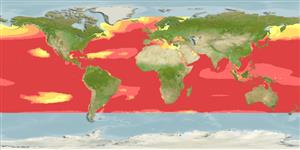>
Lampriformes (Velifers, tube-eyes and ribbonfishes) >
Lampridae (Opahs)
Etymology: Lampris: Greek, lampros = light (Ref. 45335).
Environment: milieu / climate zone / depth range / distribution range
Ökologie
seewasser bathypelagisch; ozeanodrom (Ref. 51243); tiefenbereich 0 - 500 m (Ref. 89422), usually ? - 366 m (Ref. 5951). Deep-water; 75°N - 60°S, 180°W - 180°E
Worldwide in tropical to temperate waters (Ref. 57923). Western Atlantic: Grand Banks and Nova Scotia (Canada) to Florida (USA), Gulf of Mexico and the West Indies (Ref. 7251) up to Argentina (Ref. 47377). Eastern Atlantic: Norway and Greenland to Senegal (Ref. 6737) and south of Angola (Ref. 6476) also Mediterranean. Eastern Pacific: Gulf of Alaska to south of southern California (Ref. 265). A single capture in South Georgia marks an incidental occurrence in Southern Ocean.
Size / Gewicht / Alter
Maturity: Lm ? range ? - ? cm
Max length : 200 cm TL Männchen/unbestimmt; (Ref. 5188); common length : 120 cm TL Männchen/unbestimmt; (Ref. 5217); max. veröff. Gewicht: 270.0 kg (Ref. 5188)
Rückenflossenstacheln (insgesamt) : 0; Rückenflossenweichstrahlen (insgesamt) : 48 - 55; Afterflossenstacheln: 0; Afterflossenweichstrahlen: 33 - 41; Wirbelzahl: 43. Caudal fin broadly lunate; pectorals long and falcate; pelvic fins similar to pectoral fins in shape and a little longer (Ref. 6885). Dark steely blue dorsally shading into green with silver and purple iridescence, belly rosy, body covered with silvery spots in irregular rows, light mottling on caudal and dorsal fins; vermillion on fins and jaws, golden around eyes (Ref. 6885).
Oceanic and apparently solitary (Ref. 6737). Epi- and mesopelagic (Ref. 58302). Feeds on midwater fishes and invertebrates, mainly squids (Ref. 6737). Probably spawns in the spring (Ref. 6885). Occasionally taken as a by-catch of tuna fisheries. Considered a good food fish (Ref. 5242); marketed fresh and frozen; prepared as sashimi (Ref. 9987). Swims by flapping the pectoral fins (Ref. 36731).
Life cycle and mating behavior
Geschlechtsreife | Fortpflanzung | Ablaichen | Eier | Fecundity | Larven
Palmer, G., 1986. Lamprididae. p. 725-726. In P.J.P. Whitehead, M.-L. Bauchot, J.-C. Hureau, J. Nielsen and E. Tortonese (eds.) Fishes of the north-eastern Atlantic and the Mediterranean. UNESCO, Paris. Vol. 2. (Ref. 6737)
IUCN Rote Liste Status (Ref. 130435: Version 2024-1)
Bedrohung für Menschen
Harmless
Nutzung durch Menschen
Fischereien: weniger kommerziell; Sportfisch: ja
Tools
Zusatzinformationen
Download XML
Internet Quellen
Estimates based on models
Preferred temperature (Ref.
123201): 5 - 19.9, mean 12.1 °C (based on 1423 cells).
Phylogenetic diversity index (Ref.
82804): PD
50 = 1.0000 [Uniqueness, from 0.5 = low to 2.0 = high].
Bayesian length-weight: a=0.01995 (0.00906 - 0.04395), b=3.01 (2.83 - 3.19), in cm total length, based on all LWR estimates for this body shape (Ref.
93245).
Trophic level (Ref.
69278): 4.2 ±0.62 se; based on food items.
Generation time: 5.0 ( na - na) years. Estimated as median ln(3)/K based on 1
growth studies.
Widerstandsfähigkeit (Ref.
120179): niedrig, Verdopplung der Population dauert 4,5 - 14 Jahre. (Assuming tm>4).
Prior r = 0.28, 95% CL = 0.18 - 0.42, Based on 1 data-limited stock assessment.
Fishing Vulnerability (Ref.
59153): High vulnerability (60 of 100).
Climate Vulnerability (Ref.
125649): Moderate vulnerability (38 of 100).
Nutrients (Ref.
124155): Calcium = 13 [4, 32] mg/100g; Iron = 0.295 [0.127, 0.889] mg/100g; Protein = 21.3 [16.9, 24.1] %; Omega3 = 0.148 [0.055, 0.397] g/100g; Selenium = 21.5 [7.0, 69.8] μg/100g; VitaminA = 9.27 [1.00, 83.81] μg/100g; Zinc = 0.245 [0.123, 0.529] mg/100g (wet weight); based on
nutrient studies.
